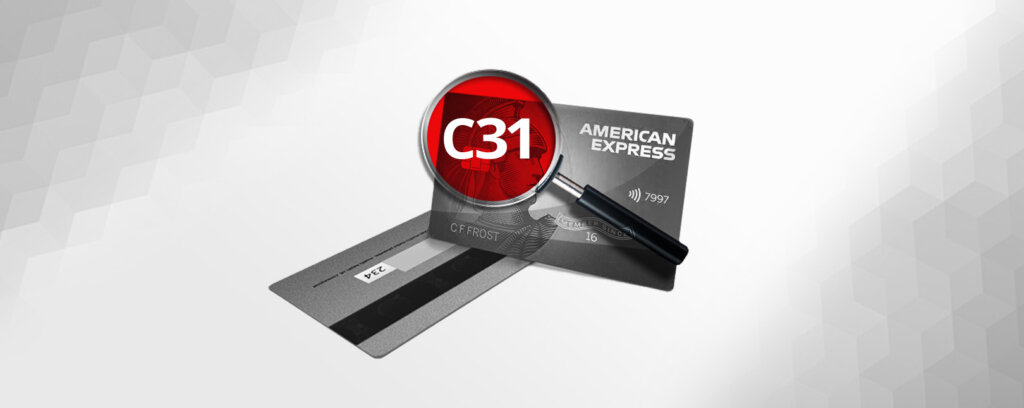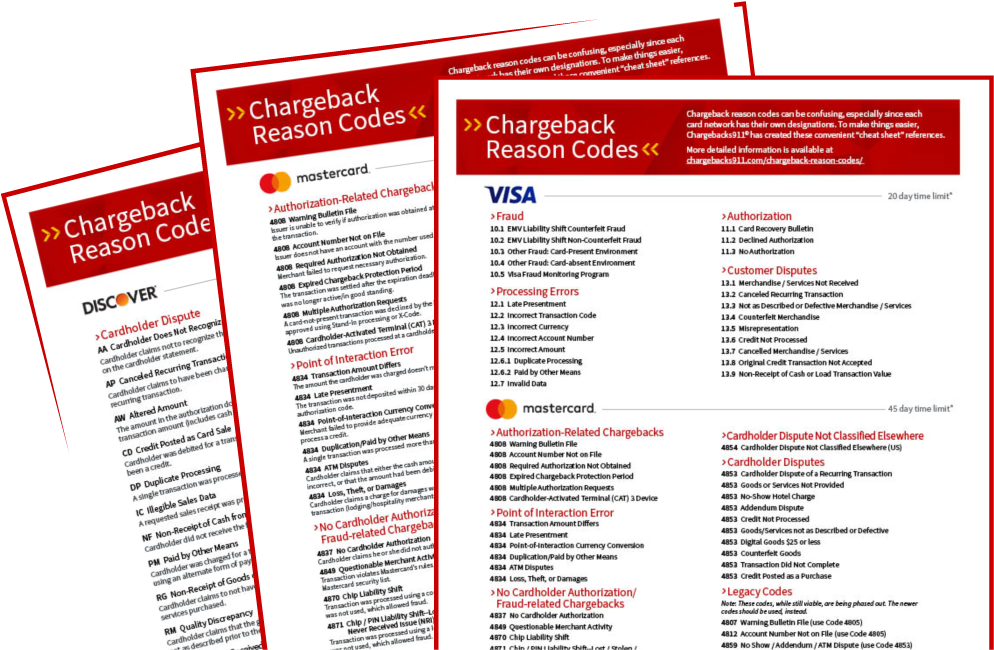
How to Handle Amex Reason Code C31 Chargebacks
American Express breaks down the acceptable causes for a customer to dispute a credit card transaction in their dispute guidelines. This is done for the sake of simplicity and standardization.
Each chargeback trigger has a designated “reason code.” Amex can then assign the appropriate code to each case to show the given reason for the chargeback.
Learn more about Amex reason codes
Today, we’re looking at one reason code in particular — C31 — and exploring the causes, timeframes, fees, and other specifics. We’ll also explore what you can do to prevent these chargebacks from happening.
Recommended reading
- Chargeback Stats: All the Key Dispute Data Points for 2025
- Credit Card Disputes | Step-by-Step Process Guide for 2025
- Mastercard Chargeback Time Limits: The 2025 Guide
- Chargebacks911® Gets in the Game for the Special Olympics!
- Chargebacks911® Food Drive in Support of The Kind Mouse!
- Can You Dispute A Dispute? Yes — Here’s What to Do
What is American Express Reason Code C31?
American Express chargeback reason code C31 is “Goods/Services Not as Described.” This reason code is used to explain that a customer authorized a purchase. However, when the goods arrived, the items shipped did not reflect what was promised.
That sounds pretty subjective. After all, how are you supposed to argue that a product does reflect the customer’s expectations?
Well, American Express specifies that this applies when the goods or services “are different than the written description provided at the time of the charge.” In other words, the product must be materially and demonstrably different from what was reasonable for the customer to expect, based on your description.
What Caused This Dispute?
Amex Chargeback Reason Code C31 is primarily issued when a product fails to meet your customer’s expectations. To demonstrate, this scenario can arise if:

How to Respond to Amex Reason Code C31 Chargebacks
What if you can convincingly prove that the products you shipped matched the description you supplied?
If you're confronted with an Amex C31 chargeback, naturally, your immediate impulse would be to rectify the complication as fast as possible. If you feel that the chargeback was initiated without a valid reason, we suggest that you respond with a counterclaim. This is done through a process called representment.
Representment gives you an opportunity to contest an invalid chargeback. In this process, you present convincing proof to the card issuing entity (American Express, in this case) that the entire transaction was conducted appropriately and according to the standards of the card issuer. This could require providing compelling evidence in order to make your case.
Bear in mind that you're bound to a strict deadline, though. You have just 20 days is all you have to submit your counterclaim to American Express. This time period includes the time your acquirer takes to communicate a dispute notification to you, and the time they spend reviewing and forwarding your case. Essentially, you may be left with a just five days or less to compile and put forth your counterclaim.
Acceptable Evidence for Amex Reason Code C31 Responses
You can re-represent these charges under the condition that you have compelling evidence. For American Express reason code C31 chargebacks, you’ll need to provide proof that the description does not differ from what was provided, as well as proof that the card member agreed to the terms of the purchase at checkout. Examples of acceptable evidence include:
- A copy of the written product description from your website
- Screencaps of the product page showcasing the item in question
- Photos of the product that was shipped to the buyer
- Transcripts of email or phone conversations between you and your buyer
- Proof that the cardholder read and agreed to your terms during checkout
Of course, you may have provided the purchaser with a credit to try and avoid a chargeback. If this is the case, it's crucial to provide documentation, showing that a credit has already been granted to offset the charge.
When it comes to tackling chargebacks, the thoroughness — and relevance — of the evidence you provide will dictate your success. Keeping a comprehensive record of all your transactions and correspondences with clients is vital. This meticulous approach will enable you to navigate all types of chargebacks, including those attributed to reason code C31.
How to Prevent Amex Reason Code C31 Chargebacks
As the old adage goes, “an ounce of prevention is worth a pound of cure.”
You may never be able to stop chargebacks entirely. But, you can limit your exposure to risk and keep your chargeback ratio in good standing by adopting a few best practices. Generally speaking, you’ll want to:
#1 | Be Sure to Ship the Right Goods
Verify shipments before sealing up the boxes and adding the label. Conduct random audits to ensure the right products are going to the right buyers.
#2 | Provide Detailed & Accurate Descriptions
Ensure that all your product descriptions are clear, honest, and accurate. There’s a big difference between talking up your products for marketing purposes, and creating a exaggerated impression of what customers should expect.
#3 | Make Contact Info Easy to Find
Make your contact information as easy to find as possible. Plaster it on every page on your site. This will make it more likely that buyers contact you to address any issues first, rather than their bank.
#4 | Simplify Returns
No one likes returns; however, they’re better than chargebacks. Ensure that your return instructions are easy to find, and that the process is simple for buyers to initiate and complete a return request.
#5 | Optimize Product Descriptions
Provide detailed written descriptions of every product on your site. Ensure that the customer knows exactly what they’re buying before completing a purchase. Explain the size, color, dimensions, etc.
#6 | Provide High-Res Photos
Include multiple high-resolution pictures of each item, showing the product from multiple angles. Include other objects in the pictures to show scale.
#7 | Respond to Refund Requests Promptly
Be quick to issue credits or replacements in response to customer complaints. Provide estimated timeframes for customers explaining when to expect a credit or replacement. Delayed responses can lead cardholders to turn to the bank.
Take a Wider View
You can dispute invalid chargebacks from Amex reason code C31. However, it’s much more efficient to take a proactive stance. The same is true of the other chargeback reason codes, as well. A truly effective chargeback management strategy must encompass prevention as well as disputing cases of friendly fraud.
Chargebacks911® can help your business manage all aspects of chargeback reason codes, with proprietary technologies and experience-based expertise. Contact us today for a free ROI analysis to learn how much more you could save.
FAQs
Does Amex investigate chargebacks?
Yes. American Express investigates chargebacks by reviewing the evidence provided by both the merchant and the cardholder to determine the legitimacy of the transaction and decide on the chargeback claim. This process ensures a fair resolution based on the documentation and arguments presented by both parties.
What is the reason code for a chargeback on American Express card?
An American Express chargeback reason code is a code that identifies the specific reason a cardholder or issuing bank has disputed a transaction, guiding the merchant on the nature of the dispute and what evidence may be required to contest it. Each code corresponds to a particular issue, such as unauthorized use, processing errors, or non-receipt of goods or services. Click here to see a full list of Amex reason codes.
Do police investigate chargebacks?
Police typically do not investigate chargebacks as they are considered a dispute between the merchant and the cardholder, handled through the card issuer's internal processes. However, if fraud is suspected as the cause of a chargeback, law enforcement may be involved in investigating the fraudulent activities.
How successful are Amex disputes?
The success of an American Express dispute depends on the merchant's ability to provide compelling evidence that the transaction was valid and in accordance with Amex policies. Success rates vary widely based on the nature of the dispute and the quality of the documentation provided by the merchant.
How does American Express investigate disputes?
American Express investigates disputes by reviewing documentation and evidence provided by both the cardholder and the merchant, such as transaction receipts, proof of delivery, or communication records, to determine the validity of the chargeback claim. This process aims to ensure a fair resolution based on the facts presented by both parties.









